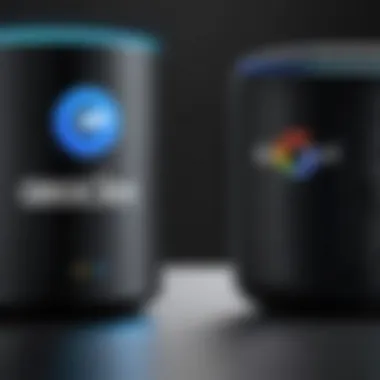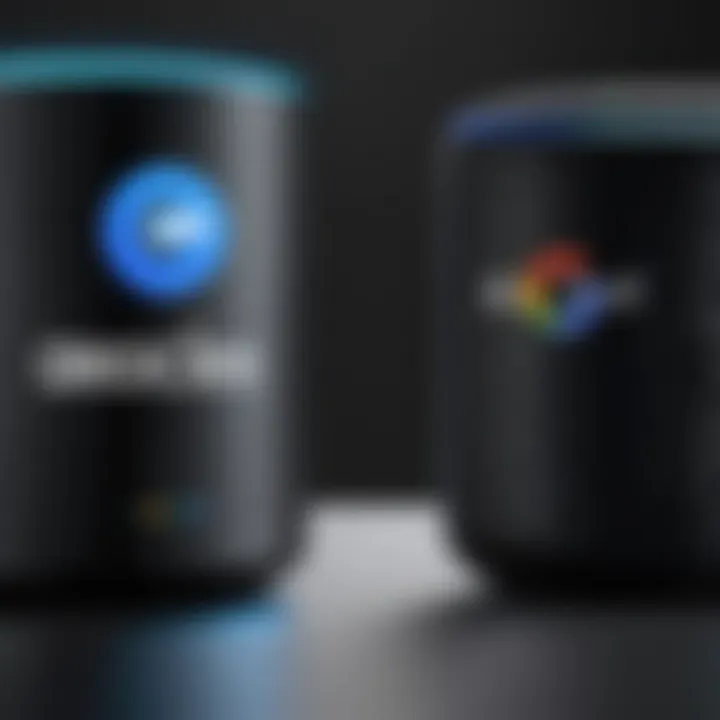Comparing Alexa and Google Assistant: A Comprehensive Review


Intro
The increasing integration of voice assistant technology in daily life has made it essential for information technology professionals to analyze the available options. Amazon Alexa and Google Assistant stand out as two leading platforms in this domain. Their growing popularity is not arbitrary; each offers unique functionalities, advantages, and limitations that can significantly impact user experience.
With Amazon’s Alexa, users engage with an extensive array of smart devices, utilizing voice commands to streamline tasks. Meanwhile, Google Assistant leverages Google's vast ecosystem and intelligent search capabilities, providing users with information in a fluid manner. Thus, the relevance of this comparison lies not just in features, but also in how these technologies complement emerging smart technologies.
Product Overview
In order to understand the strengths and weaknesses of these technologies, it is crucial to outline their essential features and technical specifications.
Key Features
Both Amazon Alexa and Google Assistant come with a robust set of features:
- Voice Recognition: Alexa utilizes machine learning to recognize diverse accents, while Google Assistant is known for its superior natural language processing capabilities.
- Smart Device Control: Alexa supports a wide variety of smart home products from numerous manufacturers. Google Assistant has strong compatibility with devices from Google and other brands, but with limitations in older device compatibility.
- Personal Assistant Functions: Both assistants can manage calendars, set reminders, and provide custom news briefings, though the manner of interaction varies.
- Third-Party Integrations: Alexa boasts a vast library of skills developed by third parties, whereas Google Assistant excels in integrating with Google services like Maps and Calendar.
Technical Specifications
The architecture behind both platforms plays a significant role in their performance:
- Amazon Alexa: Runs on an Amazon Web Services (AWS) infrastructure. It is tailored for scalable applications, offering low latency and robust security features.
- Google Assistant: Built on Google’s powerful cloud capabilities, its vast database allows for more contextual responses, enhancing its functionality.
Performance Analysis
In evaluating voice assistants, performance metrics are essential for understanding user experience.
Benchmark Test Results
Performance can be quantified using benchmark tests. Typically, both assistants are evaluated based on:
- Speed of Response: Google Assistant often exhibits quicker response times due to superior data processing capabilities.
- Accuracy of Responses: In various tests, Google Assistant has frequently outperformed Alexa in providing correct answers to factual queries.
Real-World Usage Scenarios
Considerations of how these platforms perform in practical scenarios are also important:
- Alexa in Smart Homes: Users regularly report smooth integration with smart home devices. This is particularly useful in homes focused on automation, where Alexa provides intuitive voice control.
- Google Assistant in Information Retrieval: Many users appreciate Google Assistant for its ability to pull information quickly from the web, making it ideal for answering questions in real time.
Through this analysis, both Amazon Alexa and Google Assistant are positioned well within the voice assistant marketplace, yet each caters to different user preferences and needs. As users continue to adopt voice technology, understanding the nuances between these platforms becomes essential.
Prelude to Voice Assistants
Voice assistants have gained prominence in recent years, playing a crucial role in shaping how we interact with technology. They bring convenience to users and serve as a bridge between human commands and technological execution. Understanding them is essential, especially in a landscape increasingly reliant on automation and smart devices.
This article focuses on two leading voice assistants: Amazon's Alexa and Google Assistant. By comparing both, readers can identify which tool best suits their requirements. The exploration will encompass functionality, integration capabilities, user interfaces, and privacy issues.
As technology evolves, voice assistants have been at the forefront, enhancing user experience across various aspects of life. They assist in managing tasks, controlling smart home devices, and providing information swiftly. Furthermore, delving into these voice technologies reveals important considerations about AI, data privacy, and user dependency.
In essence, the discussion on voice assistants is not merely about which is superior; it is about understanding how these tools can be leveraged effectively in daily life and business operations. Thus, this topic holds substantial relevance to IT professionals and tech enthusiasts looking to stay ahead in the rapidly changing digital environment.
Overview of Voice Assistant Technology
Voice assistant technology relies on a combination of hardware and software. At its core sits a sophisticated AI-driven engine that processes natural language input. Users interact with devices like smart speakers or smartphones, initiating tasks with spoken commands.
The primary components of voice assistants include:
- Speech Recognition: The ability to convert spoken language into text, allowing the system to understand commands.
- Natural Language Processing (NLP): This allows the assistant to interpret intent, context, and meaning from language beyond mere words.
- Response Generation: Once the assistant processes a request, it generates a fitting response, whether in information form or an action taken.
The culmination of these technologies results in a user-friendly experience that simplifies interactions with smart devices. By focusing on voice, these platforms reduce barriers that often come with traditional interfaces, promoting accessibility.
The Role of AI in Voice Assistants
Artificial intelligence underpins the functionality of voice assistants, providing the learning capacity and responsiveness that users expect. AI enables the system to become more intuitive over time through machine learning algorithms, which analyze usage patterns and improve understanding.
Key roles of AI in voice assistants include:
- Personalization: AI can adapt to user preferences, offering tailored responses and suggestions based on historical data.
- Context Awareness: By understanding context, AI can respond appropriately to commands, even when phrased differently from prior interactions.
- Continuous Learning: AI updates and refines its capabilities without human intervention. This ensures ongoing improvements in speed and accuracy.
The integration of AI transforms voice assistants from simple command responders to complex technologies that facilitate a more seamless interaction experience. Understanding this role is crucial for evaluating the potential of each platform, including Alexa and Google Assistant.


A Brief History: Alexa vs. Google Assistant
The history of Alexa and Google Assistant is essential to understanding their current capabilities and positioning within the market. These voice assistants do not just reflect technological advances; they embody the ambitious projects of their parent companies, Amazon and Google, respectively. Analyzing their origins and development offers insights into their differing functionalities and the strategic approaches to voice technology. Understanding this context is valuable for IT professionals and tech enthusiasts exploring the competitive landscape of smart technology.
Origins of Alexa
Amazon Alexa was introduced in November 2014. It was launched with the Echo smart speaker, which aimed to provide users with a voice-controlled assistant capable of managing tasks with ease. Alexa's name pays homage to the ancient library of Alexandria, symbolizing knowledge and information. The key aspect of Amazon’s strategy was integrating Alexa into its ecosystem of services, making it an essential part of the Amazon experience.
Initially, Alexa focused on providing basic functionalities: playing music, setting alarms, and managing to-do lists. However, there was continuous improvement in machine learning and natural language processing, allowing Alexa to understand context and handle complex commands more effectively.
With the release of the Alexa Skills Kit, third-party developers could create additional capabilities for Alexa. This significantly expanded its utility. The push toward smart home integration was also pronounced, with Alexa supporting various devices across different brands, establishing itself as a central hub for smart home ecosystems.
Development of Google Assistant
Google Assistant was unveiled in May 2016, initially as part of the Allo messaging app and Google Home devices. It was developed to offer a more conversational interface and leveraged Google’s extensive search capabilities. From the outset, Google aimed to create an assistant that could engage users in a more natural, human-like manner.
One of the notable features of Google Assistant was its ability to handle multi-step commands, which allowed for tasks requiring several follow-up questions. This capability marked a departure from traditional voice assistant functionalities. Google's technology, built on its existing machine learning and data infrastructure, has continuously advanced, enabling Google Assistant to enhance its understanding of context and user preferences over time.
The integration of Google Assistant into various devices and platforms, such as Android smartphones, Nest products, and even third-party speakers, has contributed to its growth in market share. The focus on leveraging existing tools such as Google Search and Maps further distinguished Google Assistant, positioning it as a powerful tool for information retrieval.
This brief history sets the stage for a more comprehensive comparison of their functionalities, integration capabilities, and overall effectiveness as voice assistants.
Functional Capabilities
In the realm of voice assistants, functional capabilities are not merely supplemental; they are integral to user experience and effectiveness. A robust set of features defines how well these technologies serve their intended purposes. As smart devices become increasingly prevalent in daily life, understanding those capabilities is crucial. Each platform, Amazon's Alexa and Google Assistant, offers unique advantages and options, thus impacting their user bases in distinct ways.
Voice Recognition Accuracy
Voice recognition accuracy plays a significant role in the performance of voice assistants. Alexa and Google Assistant both utilize sophisticated algorithms for understanding spoken commands. Google Assistant, however, is often noted for slightly higher accuracy in diverse language contexts and accents. As more users adopt these tools worldwide, this element becomes paramount. Users expect their voice assistants to understand commands quickly and with precision, no matter the dialect or background.
Task Management Features
Task management is another vital capability for voice assistants. Regular users often depend on these functions to streamline their lives, ensuring efficiency and organization.
Calendar Integration
Calendar integration is essential in task management. Users appreciate how easily they can add to or check their schedules via voice commands. Both assistants display a high degree of functionality here. For instance, Google Assistant excels with its seamless connection to Google Calendar, offering smart suggestions for meetings and appointments. This feature empowers users, minimizing the friction typically involved in managing daily tasks.
Reminder Systems
Reminder systems allow users to set up alerts for tasks and events effortlessly. Both voice assistants provide this feature, but Alexa’s integration with its ecosystem is often highlighted. Users can command, "Alexa, remind me to take medication at 8 PM," and the assistant complies, which simplifies health management significantly. However, Google Assistant tends to innovate continuously, adding capabilities that enhance the reminders experience, such as location-based reminders.
Note Taking
Note-taking capabilities provide users with tools to capture thoughts or ideas. While both platforms offer this service, Google Assistant with Google Keep tends to present a more user-friendly interface. The advantage lies in its versatility, allowing for the organization of notes with tags and categories. Ultimately, these functionalities serve a significant purpose: they help users maintain productivity and organization in life’s chaos.
Smart Home Integration
Smart home integration extends the utility of voice assistants beyond task management. The ability to control smart devices from a central platform enhances the appeal of these systems.
Supported Devices
Supported devices are critical when assessing smart home integration. Both Alexa and Google Assistant boast extensive compatibility with numerous brands and products, ranging from smart lights to thermostats. However, Alexa has a slight edge due to its longer market presence, specifically in compatibility with third-party devices. The extensive support opens a range of options for users, allowing them to customize their smart homes according to their needs.
Interoperability
Interoperability refers to how well various devices and platforms work together. Alexa's hub approach enables interconnectivity among different manufacturers. While Google Assistant shows promise, there are instances where users may find it struggles to control non-Google devices. This variation can influence users' decisions about which voice assistant to adopt, depending on their existing smart home ecosystem.
"The ability to integrate with a range of devices significantly shapes the user experience in smart homes, making interoperability crucial."
Understanding functional capabilities sheds light on the broader implications of these technologies in the smart assistant domain. Both Alexa and Google Assistant offer valuable tools, but nuanced differences can sway users toward one platform over the other.
User Interface and Experience
User interface and user experience are critical components in evaluating voice assistants like Alexa and Google Assistant. The effectiveness of these systems goes beyond mere functionality; it deeply affects how users interact with technology. An intuitive interface allows users to complete tasks efficiently and enjoyably. On the other hand, a poorly designed interface can lead to frustration and decreased usability.
Initial Setup Process
Setting up a voice assistant should be straightforward. Both Alexa and Google Assistant offer user-friendly setup processes. For Alexa, users typically begin by downloading the Amazon Alexa app. After logging in or creating an account, the app guides users through connecting the device to Wi-Fi. This process is followed by device recognition, which allows users to customize settings and link services like music or smart home devices.


In contrast, Google Assistant starts with the Google Home app. The journey is similar: users are prompted to connect their smart devices and sign in with a Google account. The integration with Google services like Gmail and Google Calendar can enhance convenience. This makes Google Assistant appealing for users already embedded in the Google ecosystem.
Voice Interaction Quality
Voice interaction quality is essential for both assistants. It defines how well the system understands and responds to spoken commands. In terms of clarity and accuracy, Google Assistant often excels in nuanced understanding and contextual awareness due to its advanced natural language processing technology. Users report that it can decipher varied accents and dialects with relative ease.
Alexa, while also capable, sometimes struggles in more complex scenarios. However, it has improved significantly through continuous updates. The experience can vary based on individual accents and environmental conditions. User feedback shows that clarity of voice recognition improves interaction satisfaction for both platforms, which is crucial for technology adoption among diverse user groups.
Customization Options
Customization is where each assistant reveals its strengths. Alexa provides extensive ability to personalize user settings, routines, and skills. Users can set specific voice commands to activate various smart home features. This level of customization enhances user satisfaction and fosters a sense of ownership over the technology.
On the other hand, Google Assistant offers strong integration with third-party services, enabling users to tailor their experiences according to their preferences. Users can adjust voice responses, add shortcuts, and choose settings to better serve their daily needs. The flexibility in customization significantly influences user experience and satisfaction.
When evaluating voice assistants, the focus on user interface and experience is crucial. An ideal system is one that is easy to set up, offers reliable voice interaction, and allows personal customization.
Performance in Real-World Scenarios
Understanding how Alexa and Google Assistant perform in real-world conditions is crucial. The practicality of these voice assistants determines their usability for everyday tasks. This section will examine two specific aspects of performance: response reliability and speed. These elements greatly influence user satisfaction and the overall effectiveness of each assistant in diverse scenarios.
Reliability of Responses
Reliability is a key factor for users who expect accurate information and consistent performance from their voice assistants. Both Alexa and Google Assistant have made strides in this area, but they do exhibit varying effectiveness under different conditions.
A user's experience often hinges on the assistant's ability to accurately understand and respond to requests. Studies have shown that both platforms excel in straightforward queries, such as asking for the weather or setting timers. However, complexity increases when users make specific or multi-step requests. For instance, if a user asks Google Assistant to find a suitable restaurant and book a reservation, it often handles this with smoother conversational flow compared to Alexa, which may require more back-and-forth interaction.
Moreover, the reliability of responses can fluctuate based on factors like background noise, accents, and user's familiarity with the platform. Google Assistant generally has a slight edge in understanding various dialects, which increases its reliability across broader user demographics.
Speed of Responses
Speed is another critical aspect of performance that impacts user experience. The immediacy of responses can greatly enhance the utility of a voice assistant. Users often rely on these tools for quick interactions—like fetching information or executing simple tasks.
Google Assistant is noted for its faster processing times in many scenarios, especially with web-based queries. Data shows that it typically processes voice commands quicker than Alexa, leading to reduced response time. This speed allows for a more efficient user experience when engaging in dynamic back-and-forth conversations.
However, the speed of Alexa’s responses is competitive and often influenced by the nature of the task at hand. Simple commands, such as controlling smart home devices, are executed rapidly, showcasing its strength in home automation.
In summary, both reliability and speed play pivotal roles in determining how effectively Alexa and Google Assistant perform in real-world scenarios. Users looking for responsive and dependable interactions should consider these factors closely.
Privacy and Security Considerations
In an era where technology shapes our daily lives, privacy and security are paramount. Voice assistants like Alexa and Google Assistant have transformed how we interact with devices, but this also raises legitimate concerns about personal data. Understanding these issues is crucial for users, especially IT professionals who must navigate such complexities.
Voice assistants rely on voice recognition and data collection to function effectively. This dependency necessitates an in-depth examination of how user data is handled. Consumers entrust these assistants with sensitive information, making it essential to scrutinize the data policies of both Alexa and Google Assistant. The importance of this scrutiny cannot be overstated; a single data breach can result in significant repercussions for the users involved.
Moreover, the transparency of each platform’s data practices plays a vital role in user satisfaction. As more individuals incorporate voice assistants into their homes, there is a growing need for clear expectations about data usage. Potential users must be informed about what data is collected, how it is utilized, and the safety measures in place to protect their information.
Data Collection Practices
Amazon's Alexa and Google Assistant both collect a variety of data to provide personalized experiences. This data may include user queries, interactions, and even information from connected smart devices. The extent of data collection can vary between the two platforms, shaped by their unique architectures and business models.
- Alexa:
- Google Assistant:
- Utilizes voice commands to tailor suggestions and manage tasks.
- Records interactions to improve recognition accuracy over time.
- Data may be shared with third-party developers for user experience enhancement.
- Integrates more deeply with Google services, tapping into user accounts for information.
- Collects contextual data from various platforms, enhancing its ability to provide relevant responses.
- Employs robust machine learning algorithms to parse and learn from spoken language inputs.
The implications of such practices extend to user trust. If users feel that their information is mishandled or too invasive, it could lead to reluctance in adopting such technologies. Users should carefully consider the trade-offs between convenience and privacy.
User Control over Data
User control over data is an essential factor in fostering trust in voice assistant technologies. Both Alexa and Google Assistant offer varying degrees of user settings that allow individuals to manage their data.
Control Features for Alexa:
- Users can delete their voice recordings through the Alexa app.
- Options are available to manage which third-party services have access to their data.
Control Features for Google Assistant:
- Similar to Alexa, users can review and delete voice data from their Google Account settings.
- Enhanced privacy settings allow users to disable personalized ads and restrict data sharing.


Despite these offerings, the reality is that data control can be complex. Users often overlook these settings or misunderstand them, leading to unintended data retention. Education on how to use these options effectively is critical to empowering users.
Market Penetration and User Base
Understanding the market penetration and user base of voice assistants is crucial for various reasons. First, it demonstrates the widespread acceptance and use of these technologies. As Amazon's Alexa and Google Assistant continue to evolve, analyzing their presence helps to understand their impact in the realm of home automation and smart technology.
Market penetration indicates how extensively a product or service has reached consumers. This metric is not solely about sales but also encompasses user engagement and the potential for growth in different demographics.
In an industry characterized by rapid technological advances, knowing the market share positions of Alexa and Google Assistant can provide insights into their strategic advantages. This data reveals which assistant presently dominates, as well as areas where each can improve or innovate. By assessing current trends, companies can tailor their solutions to meet user needs.
Market Share Analysis
The analysis of market share between Alexa and Google Assistant reveals a competitive landscape. As of late 2023, Amazon's Alexa holds a significant portion of the market, having established itself in many households through devices such as Echo and Echo Dot. Google Assistant, integrated into a range of smartphones and Google Home devices, also commands a large share of the market. According to a recent report, Alexa has about 70 million users, while Google Assistant has around 60 million users in the U.S. alone.
The competition is fierce, and both platforms innovate consistently to gain customer loyalty. Factors contributing to Alexa's stronger foothold include a greater number of compatible smart home devices and a robust ecosystem with frequent updates. Google Assistant leverages its connectivity with Google's services, making it appealing for users deeply embedded in the Google ecosystem.
Several key points to capture:
- Product Ecosystem: Alexa thrives on extensive third-party integrations.
- Device Compatibility: Google Assistant benefits from a variety of smartphones.
- User Preference: Many consumers prefer Alexa's variety of skills and ease of use.
User Demographics
User demographics play an essential role in the effectiveness and design of both Alexa and Google Assistant. Understanding who uses these technologies helps companies to refine features and marketing strategies. For example, research indicates that Alexa's user base skews slightly older, with many users aged 30 to 50 years. In contrast, Google Assistant has a larger appeal among younger individuals, especially those aged 18 to 29 years.
This demographic split informs the type of services provided. Alexa users may prioritize home automation features and shopping capabilities, while Google Assistant users may lean towards integration with search and general knowledge queries.
Additionally, regional variations influence user demographics. In urban areas, users are more likely to adopt smart home technologies, which skews the market in favor of devices like the Amazon Echo or Google Nest. On the other hand, rural areas show a slower adoption rate, influenced by connectivity issues and the cost of smart devices.
"Demographic insights not only shape innovation strategies but also influence marketing approaches to target specific audiences effectively."
Examining user demographics allows companies to address specific needs effectively, ensuring that they enhance user experience. By focusing on these aspects, a company can guide product orientation and marketing efforts, whether through targeted ads or by improving user experience based on demographic data.
Future Trends in Voice Assistants
The landscape of voice assistants is continuously evolving. Future trends in voice assistant technology are paramount for IT professionals and tech enthusiasts. Understanding these trends can help in anticipating user needs and developing strategic solutions. Several key elements are shaping the future of voice assistants.
Advancements in Natural Language Processing and the potential for AI integration loom large for both Alexa and Google Assistant. Each of these trends significantly impacts not only how these devices function but also how effectively they meet user demands. Furthermore, as voice assistants become ingrained in daily activities, considerations regarding user experience, privacy, and data security will increasingly come to the forefront.
Advancements in Natural Language Processing
Natural Language Processing (NLP) is the backbone of voice interaction. Enhancements in this area are crucial for the evolution of voice assistants. Current technology allows for basic commands and simple queries. However, future advancements will likely enable much more nuanced interaction. Imagine a voice assistant not just responding to commands but also understanding context, tone, and intent on a deeper level.
- Context Awareness: Future iterations could understand ongoing conversations, making interactions feel more natural.
- Personalization: Advanced algorithms will allow for tailored responses based on user preferences, past interactions, and behavior.
- Emotion Recognition: Integrating emotional intelligence into voice technology might allow devices to adapt responses based on user mood.
This area of tech is rapidly advancing, which means Amazon and Google will need to keep pace to maintain relevance. Continuous investment in NLP can offer users a more engaging and satisfying experience.
Potential for AI Integration
The integration of Artificial Intelligence into voice assistants presents vast opportunities. This concept extends beyond mere command execution. Integrating sophisticated AI systems can lead to improved functionalities. Here are a few ways AI can transform voice assistants:
- Smart Decision Making: Future voice assistants will likely leverage AI to perform more complex tasks, such as making recommendations based on user habits.
- Enhanced Learning Mechanisms: As both Google Assistant and Alexa improve, they can learn from user interactions more efficiently. This could allow for quicker and more intelligent response systems.
- Cross-Platform Capabilities: Future advancements in AI may also facilitate coherence between different devices and platforms, leading to a more integrated ecosystem for users.
"The integration of AI will redefine users' interactions with technology, making it more intuitive and personalized."
The End: Choosing Between Alexa and Google Assistant
In concluding this comparison, the decision between Alexa and Google Assistant is not just about selecting a voice assistant; it involves understanding user requirements and the context in which each assistan operates. Each platform has unique strengths and limitations. This section focuses on the importance of aligning these features with specific user needs and evaluating performance against broader functionalities.
Based on User Needs
User needs differ significantly across various demographics. For instance, a user focused on smart home integration might find Alexa more appealing due to its extensive compatibility with various smart home devices, leading to a more seamless experience. On the other hand, those who prioritize a natural conversation flow or require robust search functionalities may lean towards Google Assistant.
- Smart Home Users: Alexa typically integrates with a broader range of smart home devices. It can manage everything from lights to thermostats effectively.
- Search-Dependent Users: Google Assistant shines in providing immediate answers to queries using Google's search engine. This capability can be crucial for users who rely heavily on rapid and accurate information retrieval.
- Ecosystem Preference: Users already invested in Amazon or Google ecosystems will likely favor the corresponding assistant for a more cohesive experience.
Analyzing the context and specific needs reveals clear preferences that can lead to a more satisfactory usage experience. Each platform can serve best when aligned with the actual user requirements.
Performance vs. Features
When considering performance versus features, it is essential to evaluate how each platform delivers its promised functionality. Alexa, with its extensive skills and routines, offers great flexibility, allowing users to customize the assistant to perform a multitude of tasks. However, sometimes this flexibility can lead to complexity, particularly for less tech-savvy users.
On the contrary, Google Assistant tends to outperform in natural language understanding and contextual awareness, attributes essential for delivering effective and relevant responses during interactions. It captures nuances of user requests, enhancing the interaction quality.
Some key points to observe in this area include:
- Speed of Response: Google Assistant often responds faster to queries. This speed can be crucial in time-sensitive situations.
- Feature Depth: Alexa's skill integration allows users to add features as needed, potentially creating a more tailored experience. But maintaining this can require ongoing adjustments and learning.
- Natural Language Processing: Google Assistant has a more advanced approach in understanding phrases and sentences similar to human conversations, providing clarity during interactions.
In summary, while performance and features are both vital, they need to fit the user's unique context and priorities. Making a choice should involve careful evaluation of what matters most to the individual user.



